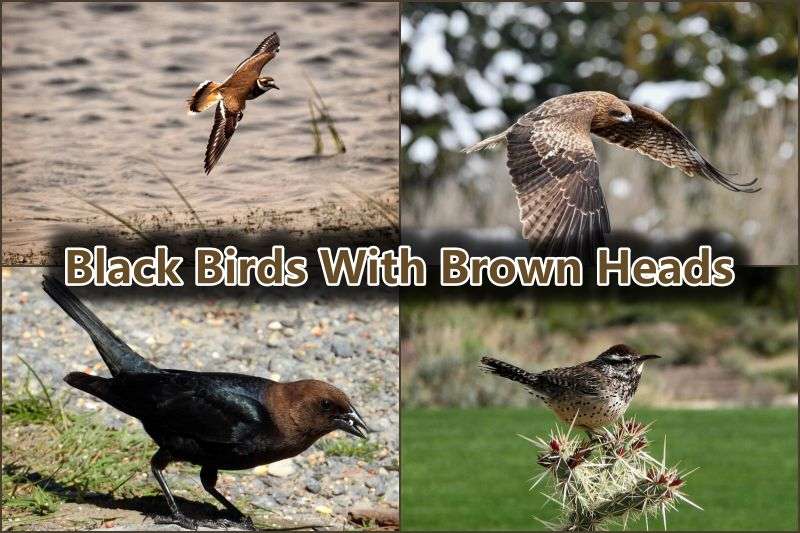This article will help you to Discover 15 Black Birds with Brown Heads, and how to identify them based on their plumage coloration and other distinguishing features. A variety of birds have brown heads with black present in varying proportions, as well as other colors.
After reading this article, you will be able to differentiate among them, and knowing their feeding habits and other behaviors, you can attract some of them to your backyards.
15 Black Birds With Brown Heads
1) Red-Tailed Hawk

| Scientific Name | Buteo jamaicensis |
| Size | 45-65 cm (18-26 in) |
| Diet | Small mammals, birds, amphibians, fishes, reptiles, and invertebrates |
| Life Span | 10-15 years |
| Geographic Location | North America |
First on the list of black birds with brown heads are red-tailed hawks.
Red-tailed Hawks are typical Buteos, having rounded and broad wings and short, wide tails. They are undoubtedly soaring raptors and are well-adapted for their lives in the air.
The Red-tailed Hawk has deep brown plumage on top with black markings, a lighter streak underneath, and a cinnamon-brown tail with a dark stripe across the bottom.
Moreover, they have black wingtips as well as a dark, black stripe across the trailing edge. These birds have undeniably sharp, curved beaks and sharp talons.
2) Black Kite
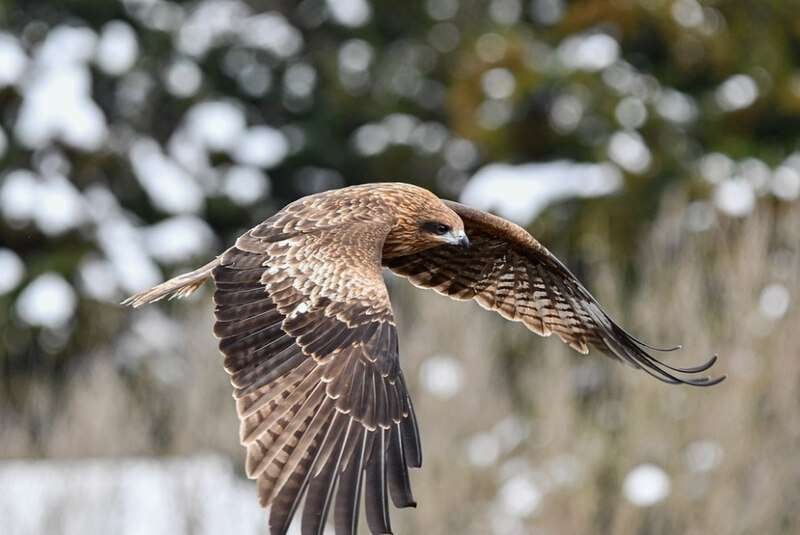
| Scientific Name | Milvus migrans |
| Size | 47-60 cm |
| Diet | Birds, bats, fishes, and rodents. |
| Life Span | 24 years |
| Geographic Location | Asia, Europe, Australia, and Africa |
Black Kites are medium-sized birds of prey that are also known as “firehawks” because of their rumored nature of picking and dumping burning twigs and starting fires so as to flush their prey.
To illustrate, they appear dark black from a certain distance but actually are gradually colored from darker brown to lighter hues of brown on lesser wing coverts, with rufous markings and little white patches. Additionally, they have an ambiguously defined forked tail and a hooked, scavenging beak.
Besides, these birds are adapted for living in densely populated urban areas and are often seen perching on electric wires, which is why they are frequently victims of electrocution.
3) Cactus Wren
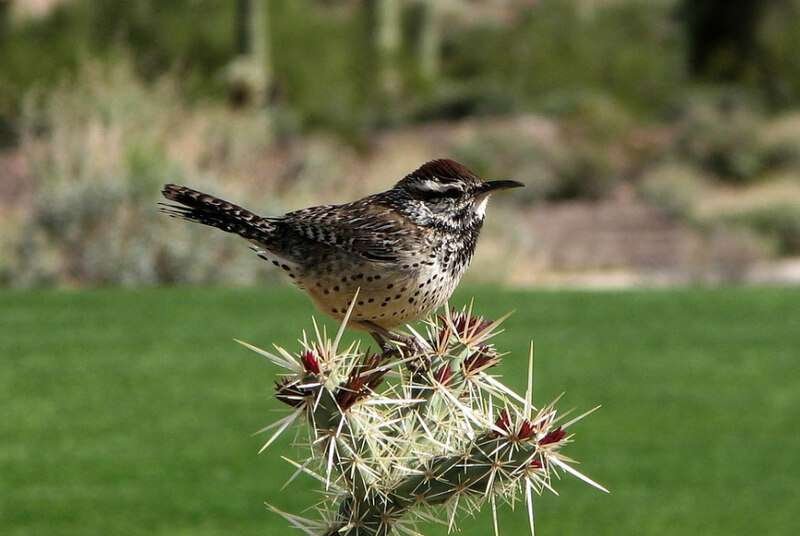
| Scientific Name | Campylorhynchus brunneicapillus |
| Size | 18-19 cm (7.1-7.5 in) |
| Diet | Insects, small reptiles, fruits, nectar, and seeds. |
| Life Span | 1-2 years |
| Geographic Location | Mexico and the United States |
Cactus Wrens are the state birds of Arizona, residing in desert environments and arid foothills and fulfilling their water needs from their diet, which consists mainly of insects but also of some vegetation materials.
Although the largest wren found in the United States, they are small-sized birds with brown heads and bold white eyebrows extending from their long, semi-curved beaks to the back of their heads.
As can be seen, they have brown plumage speckled with black and white markings and buffy underparts with black spots more concentrated on their throat.
Moreover, their tails display a beautiful pattern of alternating black and white stripes when fanned out.
4) Cooper’s Hawk
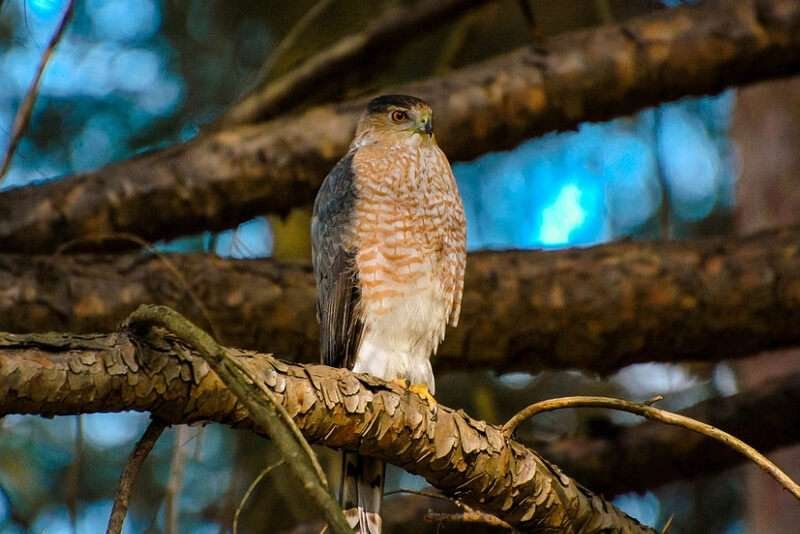
| Scientific Name | Accipiter cooperii |
| Size | 35-50 cm (14-20 in) |
| Diet | Small mammals, medium-sized birds, insects, and reptiles. |
| Life Span | 8-12 years |
| Geographic Location | North Mexico and Southern Canada |
Cooper’s Hawks are known as “true hawks” because of their deadly nature and ability to hunt large and cagey prey using extraordinary, well-developed agility, and on average, they kill two birds a day, which makes almost 700 birds in a year.
Cooper’s Hawks come in a variety of plumage, and different specimens have different eye colors ranging from yellow, orange, and red. Generally, they have pale black plumage on top with grey markings and brown or grey heads with yellowish-green crests.
Moreover, they have reticulated orangish-brown bars on their buffy, white belly, and their wings look streaked in black and white from below.
Likewise, raptorial birds have a hooked bill that is well-adapted for tearing flesh into bite-sized pieces, and their feet comprise long, curved talons for grasping and slaughtering prey.
5) Plumed whistling duck
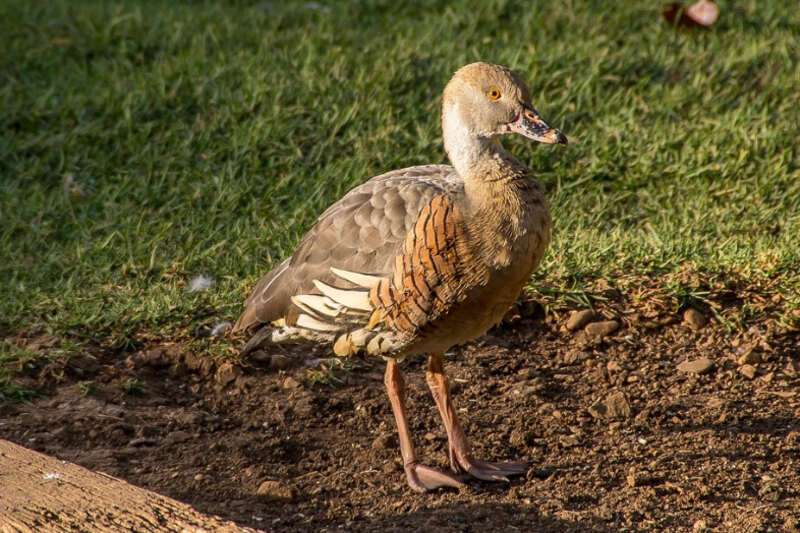
| Scientific Name | Dendrocygna eytoni |
| Size | 42–60 cm (16.5–23.5 in) |
| Diet | Tropical grasses |
| Life Span | 8-10 years |
| Geographic Location | Australia |
Plumed whistling ducks are also known as grass whistling ducks because they have tall and long necks and distinctive elongated, cream-colored flank plumes edging and extending over their backs.
In addition to their pinkish beaks, they have pink legs and orange irises. They are predominantly brown with black wings and have black streaks resting upon the cinnamon-brown upper portions of their flanks.
They usually inhabit areas near water sources, such as wetlands and grasslands.
6) Red-winged blackbird
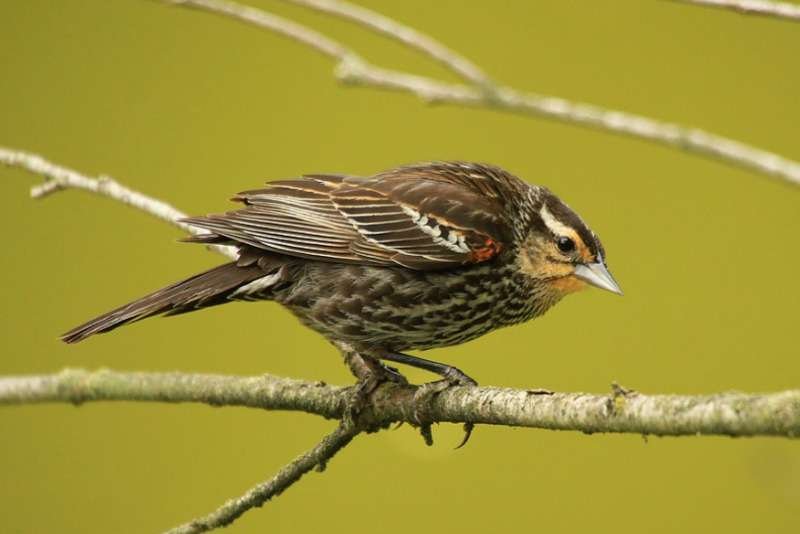
| Scientific Name | Agelaius phoeniceus |
| Size | 17–18 cm (6.7–7.1 in) |
| Diet | Seeds, grains, insects, frogs, snails, and mollusks |
| Life Span | Up to 2 years |
| Geographic Location | Southern United States and northern North America |
Red-winged Blackbirds are stocky, wide-shouldered passerine birds. Males of this species have glossy black plumage with distinctive orange or red shoulder patches and a conical, charcoal-black bill.
But we are taking female Red-winged Blackbirds, as they are black birds with brown heads. Females are heavily streaked on the undersides and black and brown on top, with streaked plumage.
In addition to their yellowish wash around the bill, they have pale beige eyebrows and a hint of manly-colored shoulders. They are highly polygamous birds that can travel up to 80 kilometers between feeding and roosting areas.
7) House Sparrow females
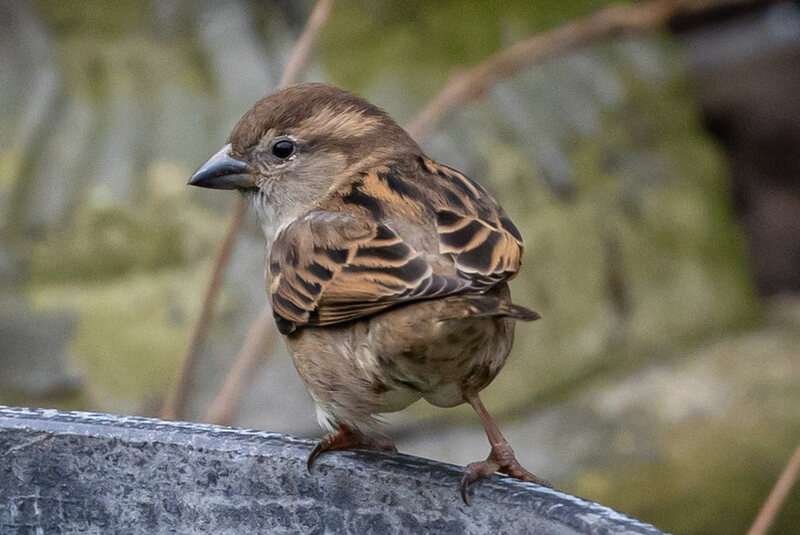
| Scientific Name | Passer domesticus |
| Size | 16 cm (6.3 in) |
| Diet | Seeds of weeds and grains. |
| Life Span | 3 years |
| Geographic Location | North Africa and Eurasia |
House sparrows are highly social birds belonging to the sparrow family, Passeridae, and have a somewhat ubiquitous distribution.
They also reside in urban settings, and instead of nesting in natural nests, they prefer to nest in man-made structures such as street lights, nest boxes, and the eaves or walls of buildings. It is quite easy to differentiate between the males and females of this species.
Males are slightly larger and have black, brown, and cream-colored markings on their backs with grey heads, white cheeks, and a black bib, while females are buffy brown and black with brown heads and beige-yellow eyelines.
Both sexes have stubby, conical bills and long, slender claws.
8) Chipping Sparrow
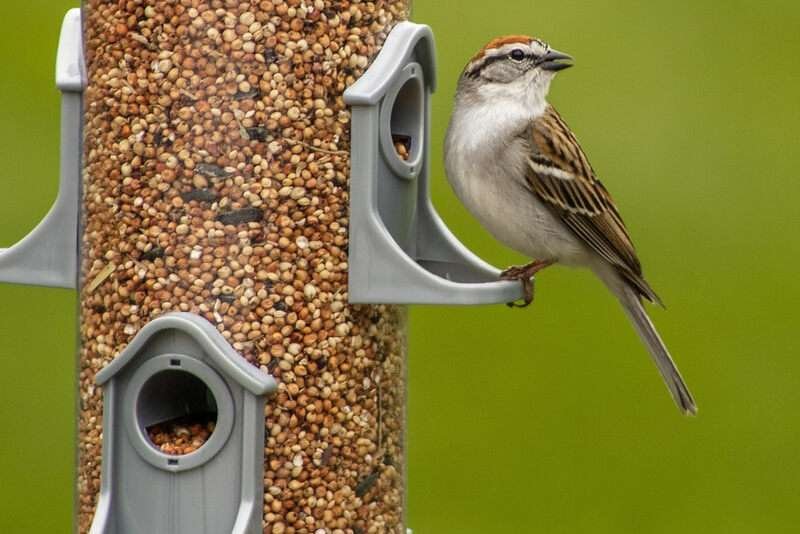
| Scientific Name | Spizella passerina |
| Size | 4.7–5.9 in (12–15 cm) |
| Diet | Seeds and insects. |
| Life Span | 4-7 years |
| Geographic Location | North America |
Chipping sparrows are passerine birds belonging to the New World sparrow family. Their appearance and plumage coloration change according to the seasons.
These birds can molt the plumage on their face and throat up to six times throughout the year, and during summers, they appear crisp and tidy, with snowy undersides, pale faces, and black eyelines topped off with a rufous brown crown.
Whereas, in winter, they are relatively drab grayish-brown below, with upper plumage darkly streaked in black, brown, and white with a weak “mustache.”
Another important point is that they have extremely strange eating habits, eating 70 times their body weight in seeds during the winter.
9) Song Sparrow
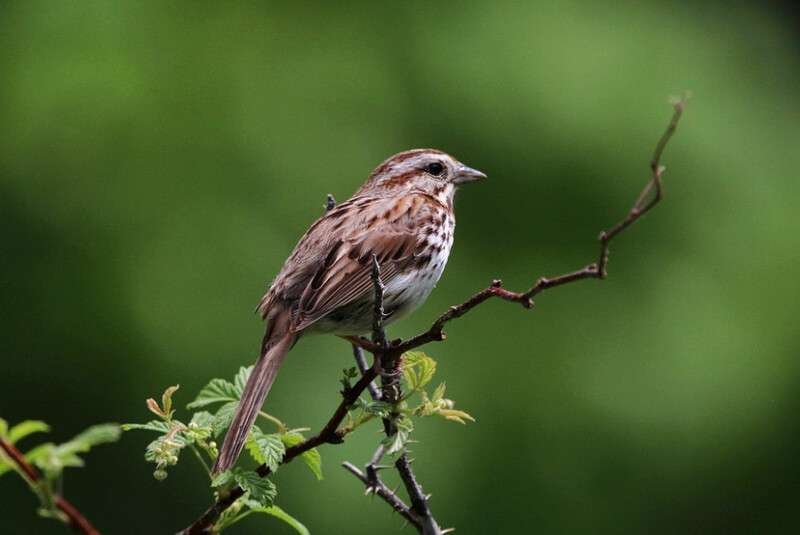
| Scientific Name | Melospiza melodia |
| Size | 11-18 cm (4.3-7.1 in) |
| Diet | Seeds, fruits, insects, and other invertebrates. |
| Life Span | 4-5 years |
| Geographic Location | Canada and the United States in North America |
Song sparrows are widespread across North America and are the most common sparrows endemic to northern American provinces.
They have undeniably heavily streaked plumage with markings in different shades of brown and black on their backs and brown heads with darker brown stripes.
They have short, pointed bills and grey or white lines across their eyes above the bills.
Song sparrows are called so because of their singing characteristics, and males of this species can sing up to 20 different kinds of melodies, and occasionally they sing songs every 8 seconds, which totals 2,300 songs throughout a day on average.
10) Pine Siskin
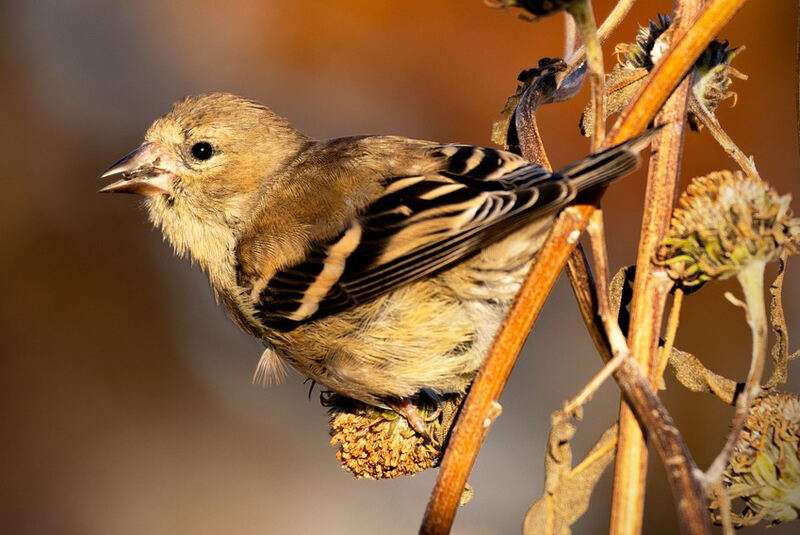
| Scientific Name | Spinus pinus |
| Size | 11–14 cm (4.3–5.5 in) |
| Diet | Plant parts, seeds, and small insects. |
| Life Span | 5-6 years |
| Geographic Location | North America |
Pine siskins are North American migratory finches famous for their fondness of salt. They are found licking salts that are used to melt ice or snow during winters along highways, and they are also observed eating flaking mortar to meet their calcium and sodium needs.
Pine siskins have mottled brown and black streaks on their backs and heads and lighter hues on their breasts and bellies. Additionally, they have black feathers on their primaries and secondaries with yellow patches.
Yellow patches are also seen on the edges of their fork-shaped tails and flanks, which flash as they take flight or while they flutter at branches. The yellow color is also displayed during mating.
11) Brown-headed Nuthatch
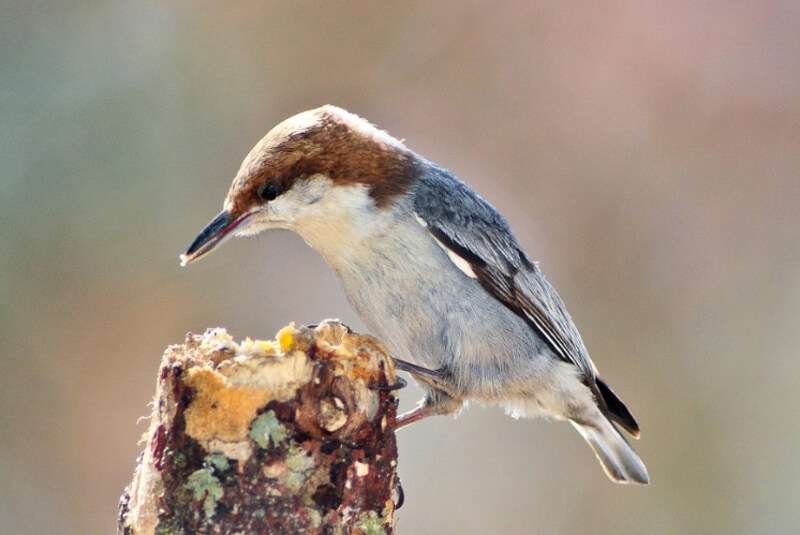
| Scientific Name | Sitta pusilla |
| Size | 9–11 cm (3.5–4.3 in) |
| Diet | Pine seeds, sunflower seeds, and insects |
| Life Span | 4-8 years |
| Geographic Location | Southeastern United States |
Brown-headed Nuthatches are small, compact songbirds that reside in mature pine forests.
They are quite intelligent and expert engineers; they make levers out of small barks to lift up food and tools from barks to pry up other scattered pieces of bark to expose insects, spiders, and seeds from underneath. Brown-headed nuthatches are non-migratory birds that perch in flocks.
It can be seen that nuthatches have a frosty face and throat balanced against gray-black plumage, are plumed with black wingtips on primaries, and have a brown head with a chisel-shaped bill.
These nuthatches can hold surfaces tight with just their claws and walk up and down on vertical tree trunks, unlike woodpeckers, who use their stiff tails for the same purpose.
12) Brown-headed Cowbird
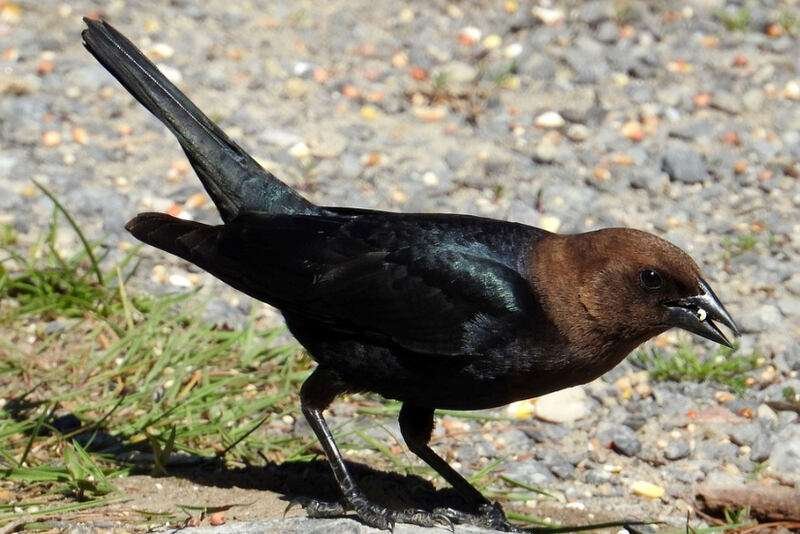
| Scientific Name | Molothrus ater |
| Size | 16–22 cm (6.3–8.7 in) |
| Diet | Seeds, grains, and insects. |
| Life Span | Up to 15 years |
| Geographic Location | Temperate and subtropical North America |
Brown-headed cowbirds are known for their reckless parenting; they take no responsibility for raising their young, and instead of building their own nests, the females lay eggs in other birds’ nests and leave as soon as they are laid without looking once.
To demonstrate, these are stumpy birds with glossy black plumage and chocolate brown heads; while males are strikingly black, females are streaked in brown and have lighter buffy plumage with a cream-colored nape and throat.
Not to mention, these blackbirds have a wider head and shorter tail in comparison to other blackbirds.
Furthermore, male brown-headed cowbirds are strictly monogamous and usually protect females from other males during breeding season, but females are polygamous and try to mate with other males, leaving their mates.
13) Killdeer
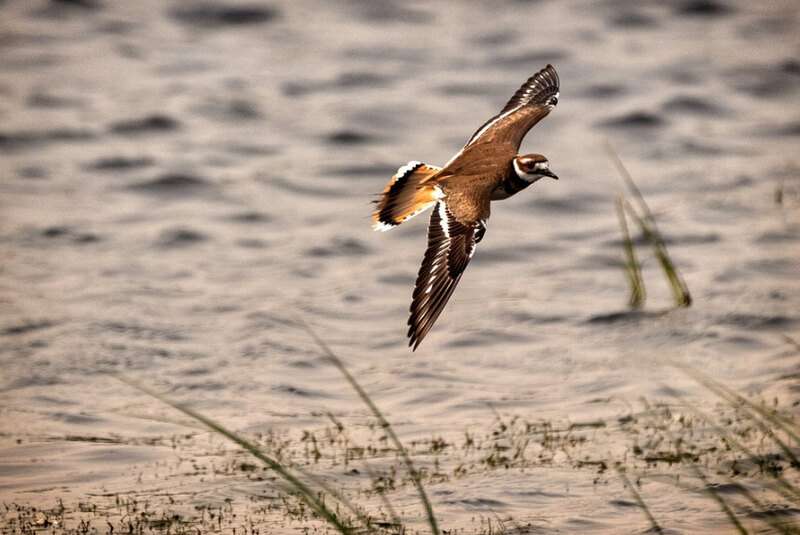
| Scientific Name | Charadrius vociferus |
| Size | 20-28 cm (7.9-11.0 in) |
| Diet | Insects, snails, spiders, millipedes, worms, and some seeds. |
| Life Span | 3-5 years |
| Geographic Location | The United States, Mexico, and southern Canada. |
Killdeers are big plovers that inhabit beach habitats, coastal wetlands, and coastal fields.
They have distinctive black bands across their neck and throat in contrast to their white undersides, coupled with rufous brown plumage on top with small black markings and streaks.
They have brown heads with two bold white stripes above their eyes and a white patch on their cere; they also have long legs and a slender, elongated black bill.
Generally, killdeer hunt their food using visual cues, such as the “foot-trembling” technique in which they stand on one foot and shake their other foot in shallow waters and peck at any prey that stirs up.
14) Brown Thrasher
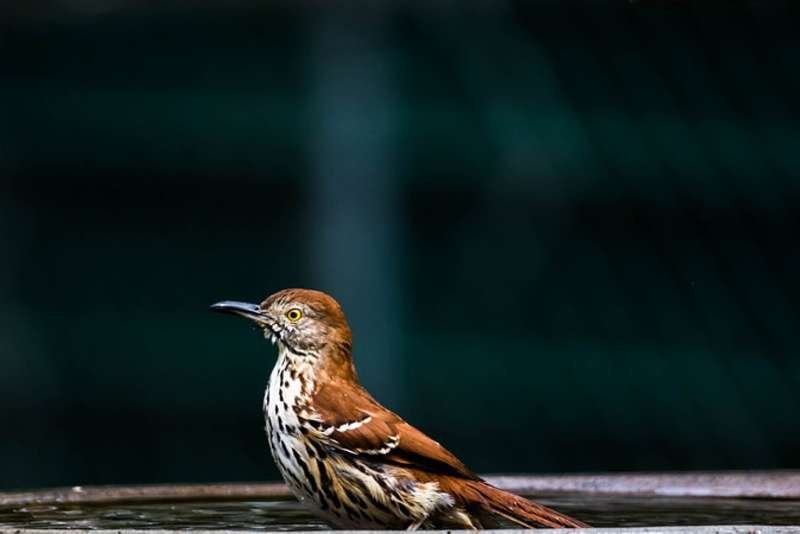
| Scientific Name | Toxostoma rufum |
| Size | 23.5-30.5 cm (9.3-12.0 in) |
| Diet | Berries, nuts, seeds, snails, earthworms, lizards, and frogs. |
| Life Span | Up to 11 years |
| Geographic Location | Eastern and central United States, central Canada, and central Texas. |
Brown thrashers are surprisingly aggressive birds and got their name from the thrashing sounds these birds make while shoving through debris and other materials.
These birds have brown plumage on their tops with black wingtips and outlines on their feathers on top of beige undersides that are mottled with black or brown blotches.
Brown thrashers are well-known for their singing abilities, as they can sing up to 1,100 different tunes, including imitating the songs of other birds.
15) Fulvous Whistling Duck

| Scientific Name | Dendrocygna bicolor |
| Size | 45–53 cm (18–21 in) |
| Diet | Aquatic worms, mollusks, and insects. |
| Life Span | Up to 11 years |
| Geographic Location | the Southern United States, sub-Saharan Africa, the Indian subcontinent of Mexico and South America, and the West Indies. |
Fulvous-whistling ducks are one of the most widely distributed waterfowl species in the world.
They are medium-sized ducks with long necks and rusty-brown plumage on their heads, chests, and bellies, in addition to black wing feathers and deep black tails.
These birds are distinguished by their blue-gray bills and legs, as well as their white elongated flank feathers that are upright or extended back.
Fulvous Whistling Ducks have zero courtship displays, contrary to many other ducks.
Conclusion:
Black birds with brown heads come from different kinds of families, including thrashers, creepers, and sparrows.
Males are more vibrantly colored to attract females, but these monotonous colors are more usually seen on females, so now you can even differentiate among different species and even specimens and must have a name for them.
Also Read:

Hey there! I’ve been the kid who used to love watching all the science stuff and that fascination lead me to choose Zoology as my Major in Graduation. I’m a self-taught writer and spend my time writing scintillating content on animals. I love observing animals behavior and their bond with humans. I want to give my point of view regarding animals i research about. I had done several projects on animals during my graduation and learned their behavior thoroughly.
